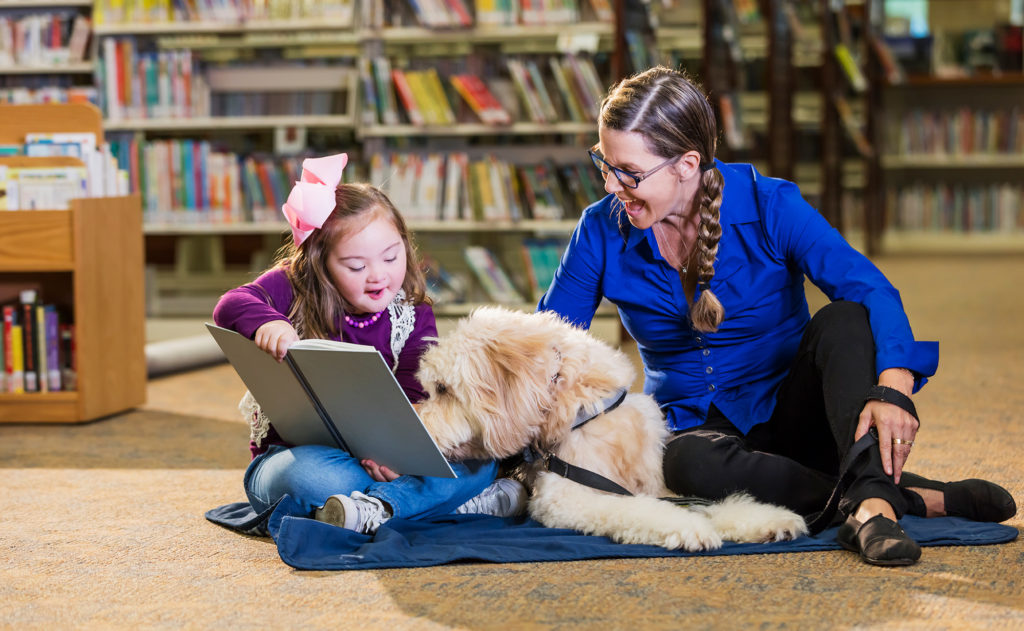A room with 40 children and a handful of dogs can be a recipe for disaster. Unless the kids and canines are gathering for Paws to Read.
“It’s just a fantastic program,” says Sandy Towers, the youth services director at the Williamsburg, Va., County Library. “You cannot walk into the room and not smile just to see all of these dogs just patiently listening to all these young readers.”
Paws to Read, a reading assistance program offered at libraries around the Peninsula, allows children ranging from just a few years old to the early teens to read to dogs to enhance their skills. Similar programs have existed across the country for decades — some programs let children read to cats. Some even allow children to read to shelter animals, which is intended not only to help with reading, but also to help the animals became less anxious and fearful and more likely to be adopted.
Reading out loud is an important skill for children to learn, says Towers. Doing so helps them work on their fluency and their pacing, and just their reading skills in general. As with learning to play a musical instrument or a sport, practice is vital. That’s where the dogs come in.
“The beauty of the dogs is that they are non-judgmental listeners,” Towers says. “Oftentimes, they’ll roll over on their backs and want their bellies scratched while you’re reading to them. Sometimes they even fall asleep while the kids are reading to them.”
Jo-Ann Wagner, leader of K-9 Connection — a therapy dog group that has worked with Paws to Read at the Williamsburg and James City County libraries for nearly 20 years — has about seven certified therapy dogs that visit the library, but she brings only five at a time. She says the children often develop a relationship with a particular dog and will look for that one to read to every week. Some kids will read to a number of dogs in an afternoon.
“It’s relaxing, certainly, sitting there petting a dog,” says Wagner, who has watched children lose their shyness around the dogs. “It gives them that comfort level to maybe encourage them to read more than they would ordinarily.”
Denise Gessner of Williamsburg says her 7-year-old daughter’s reading ability has definitely improved in the three years she’s been in the program.
“She looks forward to it,” Gessner says. “They give out bookmarks with the schedule, so she reminds us of the date. She’ll let us know it’s Paws to Read day and we have to get ready.”
Her daughter is more excited about the Paws to Read program than she is about reading assignments at school, Gessner says. At the library, there’s no peer pressure. “It’s a dog listening to her,” she says. “The dogs are really forgiving.”
Towers noticed improvement in her own daughter — now a student at Virginia Tech — when she was in the program years ago. Reading to the dogs prompted her to read aloud at home and to her teachers at school.
“Giving kids opportunities to read in different settings and read out loud to different listeners is important,” she says. “But to have just another opportunity, a different opportunity, a different listener, a different setting, I think is important for children as they grow as readers.”
Paws to Read classes typically are held once a month for about an hour. On a hot Sunday afternoon in the middle of July at the Williamsburg library on Scotland Street, there was almost as much petting and brushing of dogs as there was reading. One child read aloud a book from the Clifford series — which is about a giant dog.
“One of the fun things is the kids get to know their favorite dog and will pick books to read to their dog that they believe their dog will really enjoy,” Towers says. “They just really believe that and are very inspired and encouraged to read because they want to read to the dogs.”
Reading out loud to dogs can help children:
- Sustain concentration and focus
- Maintain a higher level of awareness
- Improve attitudes toward school
- Increase reading comprehension and fluency
- Expand their use of vocabulary and language
- Boost confidence and pride in their reading skills
- Cultivate a higher motivation for reading and learning
- Foster positive social interactions
- Feel more comfortable about learning
- Enjoy the experience of reading
Source: Pawstoread.com



